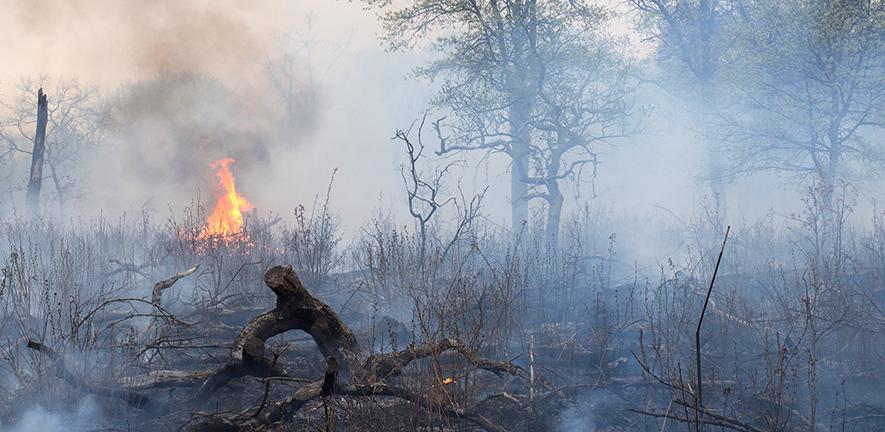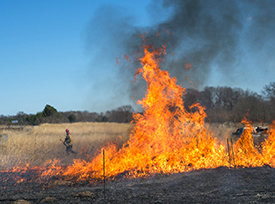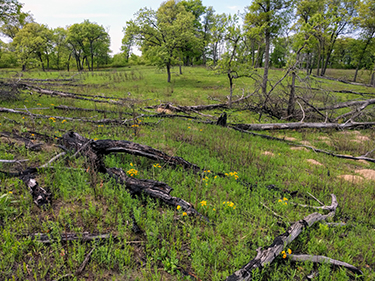
Submitted by Anonymous on Tue, 22/11/2022 - 10:50
Modelling the future of soils in the world’s savanna-grasslands – new tools to help manage 24 million square km of drylands
A new grant from the ERC's ‘Starting Grants’ scheme will fund studies to improve carbon credit schemes in dryland areas by boosting our grasp of the effects of periodic fire events on carbon capture and storage.
Managing ecosystems to promote carbon sequestration, either by avoiding further loss or stimulating new sequestration, is considered a major means to combat climate change. In drylands, however, there is lack of clarity of the possible detrimental effects of such management on ecology, and doubt over the sustainability of some of the options adopted.
Towards better carbon flux models
The project will give insight into how fire management can affect carbon storage and plant communities in drylands by quantifying the mechanisms leading to changes in soil carbon through a network of fire manipulation experiments spanning global drylands. The models developed in the project will help address questions around the rates of potential carbon sequestration, maximum storage capacity, and the optimal environmental conditions to promote carbon sequestration whilst maintaining other ecosystem functions such as biodiversity.
‘The project will enable us to develop models of carbon flux that are more representative of drylands, where a much higher proportion of plant biomass is found in underground organs that are less affected by fires,’ said Dr Adam Pellegrini, project leader and post-doctoral research fellow in the Department of Plant Sciences. ‘We’ll also look at the potential of managed fire events to increase carbon capture and storage, an aspect that has rarely been explored despite promising indications. The models that we develop will then be used to implement a carbon-credit payment scheme for drylands in the United States, with our commercial partners.’
Boosting management and investment decision-making
The research will develop and test tools and models that will help boost decision-making on up to 24 million square km of savanna-grassland drylands globally.
‘The soil carbon dynamics models that currently underpin the ‘Dynamic Global Vegetation Models’ used by the IPCC don’t fully reflect the enriching effects of fire on soil carbon content, and neither do they capture the ways that fire reduces vegetative decomposition and the resulting lessening of the loss of carbon to the atmosphere. Our work will contribute to improving predictive methods such as these, and to better long-term management and investment strategies that can help limit climate change.’ said Dr Pellegrini.
The first three years of the project will involve intensive field and lab work, surveying fire experiments in 15 different locations distributed across North and South America and Africa in collaboration with seven other universities. Following data collection, the project team will build the ecosystem models and work towards economic implementation.
The project is one of over 400 to have been awarded funding under the European Research Council (ERC) Starting Grants 2022 scheme this November.
Useful links
Adam Pellegrini - https://www.plantsci.cam.ac.uk/directory/adam-pellegrini
Disturbance ecology and ecosystem function research group - https://www.plantsci.cam.ac.uk/research/groups/disturbance-ecology-and-ecosystem-function
More background on Dr Adam Pellegrini's research - https://www.plantsci.cam.ac.uk/news/controlled-burning-natural-environments-could-help-offset-carbon-emissions
++++++++++++
Project profile: ‘Determining the potential for soil carbon storage under different fire regimes in drylands’
The project aims to boost our understanding of how fire affects soil carbon content, emissions and sequestration in dryland ecosystems, and to apply this new knowledge in the US carbon credit marketplace.
Soil organic matter is the largest storage pool on land and a key focus in many carbon offset schemes. Managing ecosystems to maximise their capacity to store carbon while maintaining key ecosystem functioning and services is an essential component of our pathway to net zero carbon emissions. Consequently, rigorous models to estimate how management will change ecosystem carbon, and an understanding of how future climate change threatens carbon storage are both required. This research will create a tool that can be broadly applied to enhance accuracy of offsetting projects while furthering our understanding of mechanisms in the basic science of ecosystem carbon cycling.
Component 1. Carbon flux survey
Researchers will measure how carbon fluxes differ in plots subjected to different fire frequency treatments for 35-60 years, distributed across fifteen sites, to investigate the hypothesis that larger fire effects on plant biomass productivity and inputs into soils may be the dominant factor leading to larger changes in soil carbon, especially due to changes in root biomass, but the stability depends on important mineral-microbial-carbon interactions.
Component 2. New models of carbon and nitrogen cycling
The field surveys will reveal the mechanisms controlling fire effects on ecosystem carbon to springboard the development of a new ecosystem model. By measuring decomposition activity, soil organic matter chemistry, and plant biomass inputs over two years, the researchers will develop new models and compare the model’s outputs with historical models to understand how changes in soil stability modify the effects of fire on soils.
Component 3. Quantification of potential for managed fire events
The final stage of the project will implement the carbon cycling model across USA rangelands to better understand how changes in disturbances may lead to contrasting carbon storage in ecosystems, and testing their application in the US carbon credits marketplace.
Project partners
Sarah Hobbie, University of Minnesota, https://cbs.umn.edu/contacts/sarah-e-hobbie
Peter Reich, University of Michigan, https://seas.umich.edu/research/faculty/peter-reich
Robert Pringle, Princeton, https://eeb.princeton.edu/people/robert-pringle
Corli Coetsee and Benjamin Wigley, South African National Parks
Jack Brookshire, https://landresources.montana.edu/directory/faculty/1523942/elan-brookshire
Emma Fuller, Corteva Agrisciences
Bonnie Waring, Imperial College London, https://www.imperial.ac.uk/people/b.waring


